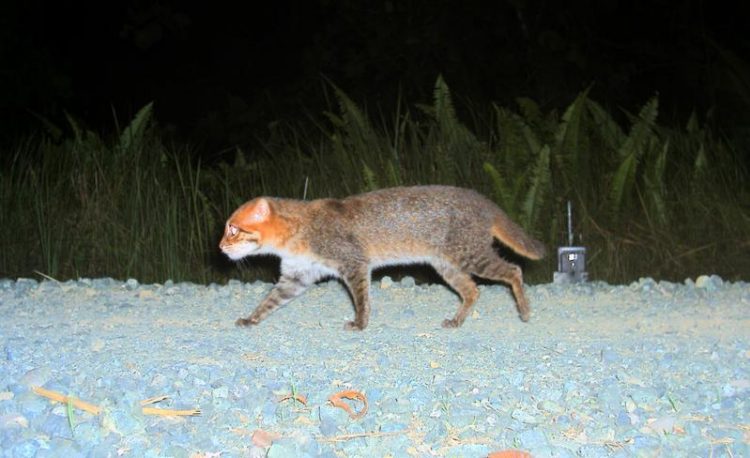Roadmap for better protection of Borneo’s cats and small carnivores

Flat-headed cat: camera-trapped in Tangkulap Forest Reserve, Sabah, Malaysian Borneo on 18 March 2009. Credit: Mohamed & Wilting/IZW, SFD, SWD
Borneo harbours more endemic carnivores than any other island except Madagascar and about half of these carnivores are globally threatened with extinction. In response to these threats and the paucity of knowledge about Bornean carnivores, three IUCN SSC specialist groups (the Cat Specialist Group, the Otter Specialist Group and the Small Carnivore Specialist Group), in collaboration with the Sabah Wildlife Department and the Leibniz Institute for Zoo and Wildlife Research, organised the Borneo Carnivore Symposium (BCS) in 2011.
“The goal of the BCS was to understand better the distribution and conservation needs of Bornean cats and small carnivores and subsequently, to enable targeted conservation efforts to those carnivores which are most threatened,” said Dr. Andreas Wilting, scientist at the IZW and lead editor of this supplement. “We achieved this goal through a collaborative effort of the Borneo Carnivore Consortium, a network of more than 60 national and international scientists, conservationists and naturalists working on Borneo.”
The results are 15 small carnivore and 5 wild cat papers which discuss the distribution, conservation and research priorities for each of the 20 Bornean small carnivores and cats. The intent to model the distribution of the four Bornean otters could not be realized because too few records could be traced. Dr. J. W. Duckworth, the IUCN SSC Red List Authority for small carnivores, adds, “The conservation status of the carnivores which occur nowhere but Borneo and those of upper highland, extreme lowland and wetland habitats is particularly worrying.
The BCS and this supplement were able to provide important new information which was recently used to update the Red List accounts, thereby enabling governmental agencies and other conservationists to focus efforts and resources on these threatened species.”
The flat-headed cat and the otter civet are two such lowland and wetland specialists. “They are well equipped to hunt fish with their webbed feet but to do so, they require natural wetlands – habitats which are rapidly shrinking,” explains Wilting. Last year, peatlands and lowlands in Indonesia were burning for months, an environmental and ecological disaster, increasing the threat of extinction for these species.
Equally threatened, but restricted to the highlands are Hose’s civet and Bornean ferret badger. John Mathai, lead author of the overarching carnivore community paper in the supplement and a wildlife ecologist from Sarawak, Malaysian Borneo, studies Hose’s civet in the highlands of Sarawak. He explains that these highland species are particularly vulnerable to the effects of climate, but also habitat, changes. “However, besides changes in climate and habitat and threats from illegal hunting, bushmeat trade and forest and peatland fires, the major conservation issue facing Bornean carnivores is the lack of awareness on the gravity of the problem,” Mathai adds.
The Borneo Carnivore Consortium hopes this supplement will serve as a catalyst for future collaborative conservation initiatives between scientists and practitioners. William Baya, Director of the Sabah Wildlife Department adds, “We need more joint conservation efforts with the oil palm and forestry sector and better collaboration of scientists and conservationists with local authorities to protect the diversity of carnivores in the remaining rainforests of Borneo.” Here, the published roadmap will provide guidance about needed activities in key carnivore landscapes.
Publication
Special supplement
Distribution of and conservation priorities for Bornean small carnivores and cats. Raffles Bulletin of Zoology Supplement No. 33. Editors: Andreas Wilting, J.W. Duckworth, Christine Breitenmoser-Würsten, Jerrold L. Belant and John Mathai.
Overarching carnivore community paper:
Mathai J, Duckworth JW, Meijaard E, Fredriksson G, Hon J, Sebastian A, Ancrenaz M, Hearn AJ, Ross J, Cheyne S, Borneo Carnivore Consortium & Wilting A (2016) Carnivore conservation planning on Borneo: Identifying key carnivore landscapes, research priorities and conservation interventions. Raffles Bulletin of Zoology, Supplement 33: 186–216.
Contact
Leibniz Institute for Zoo and Wildlife Research (IZW)
in the Forschungsverbund Berlin e. V.
Alfred-Kowalke-Str. 17
10315 Berlin
Germany
John Mathai
Tel.: +49 30 5168-722
mathai@izw-berlin.de
Andreas Wilting
Tel.: +49 30 5168- 333
wilting@izw-berlin.de
Steven Seet (Press)
Tel.: +49 30 5168-125
seet@izw-berlin.de
Additional photos showing the diversity of Bornean carnivores:
https://www.dropbox.com/sh/tnyjqdoy7novfz4/AAAHwocbfT8VM-PBd7D_vWWxa?dl=0
Media Contact
More Information:
http://www.fv-berlin.deAll latest news from the category: Ecology, The Environment and Conservation
This complex theme deals primarily with interactions between organisms and the environmental factors that impact them, but to a greater extent between individual inanimate environmental factors.
innovations-report offers informative reports and articles on topics such as climate protection, landscape conservation, ecological systems, wildlife and nature parks and ecosystem efficiency and balance.
Newest articles

Magnetic tornado is stirring up the haze at Jupiter’s poles
Unusual magnetically driven vortices may be generating Earth-size concentrations of hydrocarbon haze. While Jupiter’s Great Red Spot has been a constant feature of the planet for centuries, University of California,…

Cause of common cancer immunotherapy side effect s
New insights into how checkpoint inhibitors affect the immune system could improve cancer treatment. A multinational collaboration co-led by the Garvan Institute of Medical Research has uncovered a potential explanation…

New tool makes quick health, environmental monitoring possible
University of Wisconsin–Madison biochemists have developed a new, efficient method that may give first responders, environmental monitoring groups, or even you, the ability to quickly detect harmful and health-relevant substances…



